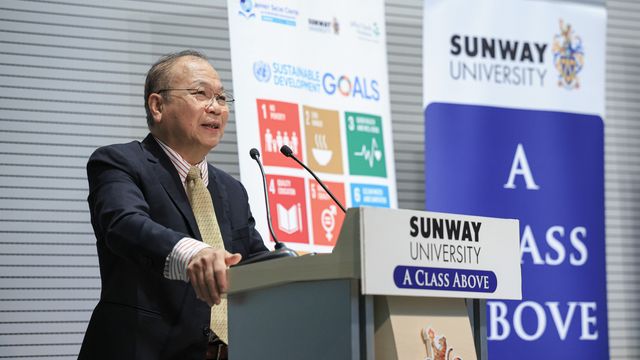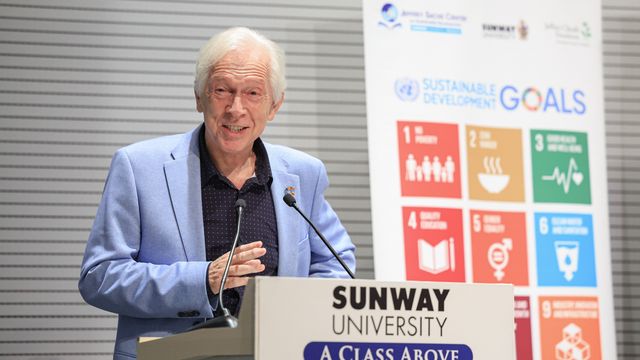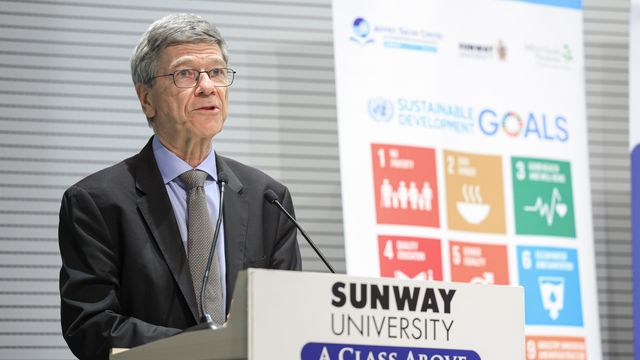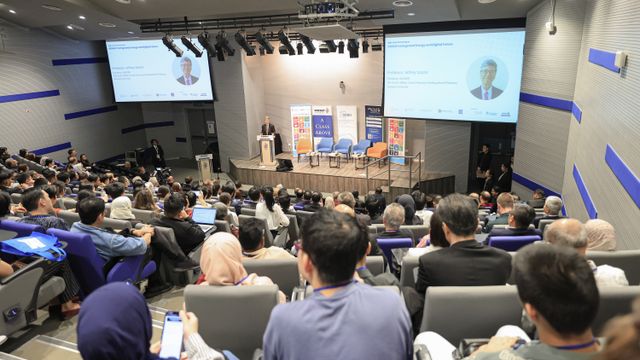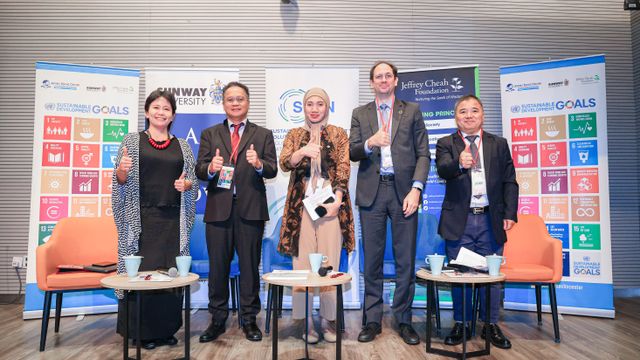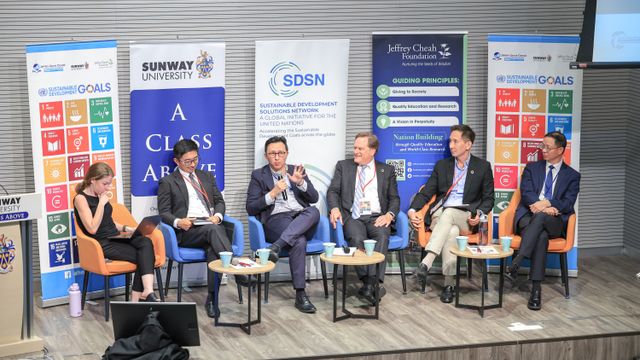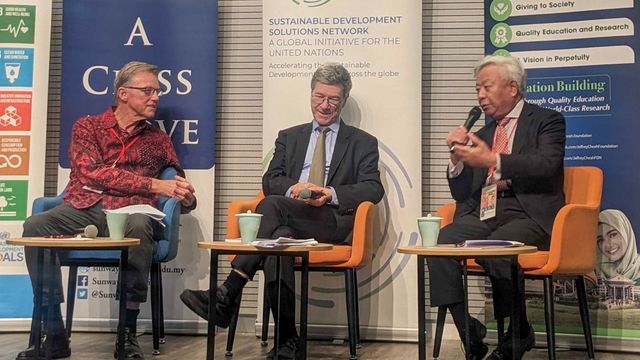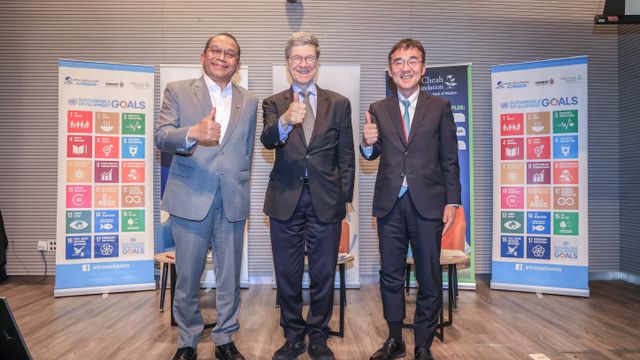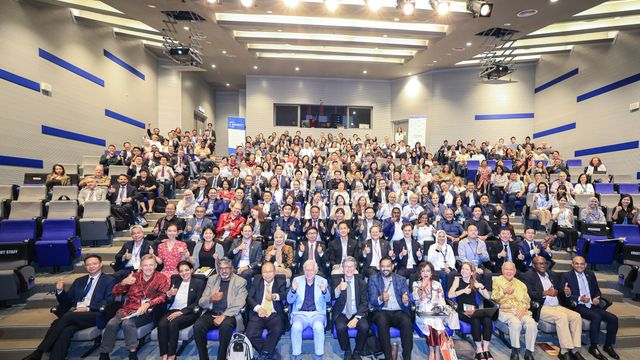High-Level Convening on ASEAN’s Integrated Energy and Digital Future
On May 25, 2025, in Sunway City, Kuala Lumpur, Malaysia, on the eve of the ASEAN-Gulf Cooperation Council Summit, the ASEAN Power Grid (APG) community converged, sharing understanding and seeking luminous paths forward.
Despite the promise of the APG, only nine of the eighteen priority interconnection projects have been completed to date. Most of the cross-border power interconnections in Southeast Asia are bilateral. The 2022 launch of the Lao PDR–Thailand–Malaysia–Singapore Power Integration Project achieved a significant milestone, marking the region’s first multilateral cross-border electricity trade. To realize the vision of a fully integrated and resilient regional grid, it will be crucial to expand participation, especially by including major players such as Indonesia and the Philippines.
The need for power sharing is increasingly urgent, as electricity demand in Southeast Asia is expected to grow by 4% annually, putting the region on track to surpass the European Union’s total electricity consumption by mid-century. A well-developed APG could play a transformative role in meeting this rising demand by cutting system costs, strengthening energy security, and accelerating the adoption of renewable energy across the region.
To facilitate dialogues around energy sharing and connectivity, the UN Sustainable Development Solutions Network (SDSN) and the Columbia Center on Sustainable Investment (CCSI) hosted a High-Level Convening on ASEAN’s Integrated Energy and Digital Future (AIEDF) ahead of the ASEAN Summit.
Opening the AIEDF
The event kicked off with introductory speeches from Professor Woo Wing Thye, Vice-President of the SDSN’s Asia Headquarters at Sunway University, and Professor Sibrandes Poppema, President of Sunway University, representing Tan Sri Sir Dr. Jeffrey Cheah KBE AO, Chairman of the Sunway Group.
In his welcome address, Woo unveiled the genesis and vibrant progress of the ASEAN Green Future (AGF) initiative. Born in the shadows of the COVID-19 pandemic and forged in collaboration with Climateworks Centre at Monash University, this ambitious project illuminated ASEAN’s path to decarbonization.
Woo underscored that while the blueprints of technical and economic feasibility studies are now complete, implementation and financing remain challenging. He passionately argued that the solitary pursuit of net-zero emissions is a path of inefficiency and called instead for the unified strength of regional cooperation.
Woo painted a picture of a future in which green energy, flowing from the abundance in Laos and Sarawak, could cross borders, enriching all. His words resonated with deep appreciation for the unwavering support from international and regional allies, including the ASEAN Centre for Energy, the Asian Development Bank (ADB), and the CCSI. Woo also extended heartfelt gratitude to the Jeffrey Cheah Foundation and Sunway University for their transformational financial and institutional support.
Poppema highlighted the Jeffrey Cheah Foundation’s mission to advance sustainability and education, underpinned by nearly RM 1 billion in scholarships. He further emphasized the Foundation’s commitment to funding the ASEAN Green Future project since 2021. This project, he noted, embodies ASEAN’s collective spirit and addresses the urgent need to prioritize regional stability, enhance safety, deepen economic integration, and establish a globally competitive, low-carbon energy system — a system poised to powerfully drive and illuminate the region’s advanced and digital economy.
The AGF project transcends mere collective ambition; it is a dynamic force actively shaping a sustainable tomorrow. Beyond its foundational work in modelling near-zero emissions power systems and optimizing cross-border power interconnections across ASEAN, this initiative is already fostering a vibrant ecosystem of impact. It serves as a catalyst for a greener future, giving rise to several crucial initiatives that will define our energy landscape:
- Enhancing Malaysia’s Energy Transition Model: Collaborating with the European Commission-funded RE-CONNECT initiative, AGF is developing an advanced model to strategically optimize Malaysia’s shift from natural gas toward a robust future of renewable energy, nuclear power, and cutting-edge energy storage. This will provide actionable recommendations for policy and investment.
- Strengthening Regional Resilience: In March 2025, SDSN launched the ASEAN Resilient Grid Capacity Building Programme. Forged in partnership with the Global Energy Interconnection Development and Cooperation Organisation (GEIDCO) and significantly bolstered by the Ministry of Energy and Environmental Sustainability of Sarawak, this initiative will empower nations to build robust and adaptive energy infrastructures.
- Fostering Intellectual Leadership: The SDSN is proud to serve as an Academic Partner for the ASEAN Centre for Energy at the upcoming 5th ASEAN Energy Conference in Kuala Lumpur this October 2025. This collaboration provides a crucial platform for knowledge exchange and collaborative thought leadership.
He concluded by reaffirming the Foundation’s conviction that regional cooperation, education, and solutions-oriented action are paramount for securing ASEAN’s sustainable future.
In his opening speech, Professor Jeffrey Sachs, the SDSN’s President, delivered a candid and urgent address on the need for regional cooperation in transforming ASEAN’s energy system. He framed the issue within the broader global failure to resolve the climate crisis despite over three decades of international negotiations. The central challenge, he noted, is the decarbonization of the global energy system, which remains deeply reliant on fossil fuels. Sachs stressed that the world has already surpassed the proposed 1.5°C warming cap and is likely to reach 2°C within two decades, risking catastrophic climate tipping points.
He identified three key reasons why progress has stalled:
- The complexity of the energy system, which underpins all modern economies.
- Lack of regional coordination, as climate frameworks like the Paris Agreement emphasize national rather than collaborative efforts.
- Governments’ limited capacities to plan and implement long-term, cross-border infrastructure and technology solutions.
Sachs argued that current frameworks, like the Paris Agreement’s five-year Nationally Determined Contributions (NDCs), are inadequate. Instead, he advocated for 30- to 40-year backcasting strategies that prioritize long-term goals and regional cooperation. He criticized the lack of effective planning and coordination among countries.
He highlighted East Asian countries — particularly ASEAN, China, Korea, and Japan — as the actors best positioned to lead the global energy transformation, noting that China already dominates in renewable deployment. Sachs called on ASEAN, under Malaysia’s current chairmanship, to move from decades of discussion to concrete action, including the long-envisioned APG.
He concluded with optimism, stating that those who lead the transition early will gain long-term economic and geopolitical advantages while also serving the global common good. The challenge is daunting but inaction, he warned, is no longer an option.
Panel One: Opportunities and Challenges for the ASEAN Power Grid
The first panel discussion, “Opportunities and Challenges for the ASEAN Power Grid,” convened a distinguished group of experts to delve into the complexities of regional energy integration. The panel featured Ir. Bunyak Lunyong of SEB Power (representing the Deputy Minister of Energy and Environmental Sustainability, Sarawak), Nadhilah Shani from the ASEAN Centre for Energy (ACE) (representing ACE’s Executive Director), Matthew David Wittenstein of the United Nations Economic and Social Commission for Asia and the Pacific (UNESCAP), and Dr. Feng Limin from GEIDCO (representing GEIDCO’s Chairman).
Thoughtfully moderated by Professor Leong Yuen Yoong from the SDSN’s Asia Headquarters at Sunway University, the session explored the APG’s ambitious vision, architecture, and dynamic processes.
To set the scene, Leong presented a key finding from the AGF project, highlighting a significant divergence in APG prioritization among ASEAN member states. While some nations are actively engaged, Indonesia, the Philippines, and Myanmar currently do not prioritize the APG in their national energy strategies. Consequently, five and a half of the eighteen identified priority APG interconnections are currently sidelined: Peninsular Malaysia – Sumatera; Batam – Singapore; Philippines – Sabah; Thailand – Myanmar; Singapore – Sumatera; and Kalimantan – Java. Given this, she recommended focusing APG strategic planning efforts on countries that are “ready, willing, and able.”
Shani from ACE explained that “The ASEAN leaders’ vision is for the region to be fully interconnected by having cross-border interconnection between member countries by 2045.”
To drive regional energy integration forward, she underscored that ASEAN must prioritize accelerating feasibility studies for remaining interconnection projects, bringing them to a bankable, investment-ready stage. Equally crucial is the development of streamlined, multilateral market mechanisms, supporting dynamic, real-time electricity trading. Such mechanisms, she noted, would better accommodate the variability of renewable sources like hydropower and respond more flexibly to fluctuating demand, enhancing both efficiency and resilience in ASEAN’s power trade.
Meanwhile, Sarawak, Malaysia’s largest state, is strategically positioning itself as a key player in this energy transition. Through the development of the Borneo Grid, Sarawak aims to become a central contributor to the APG. “We want to be the battery of ASEAN,” Lunyong, CEO of SEB Power, a subsidiary of Sarawak Energy Bhd, stated.
Lunyong elaborated that their vision is to drive sustainability by developing its renewable energy industry and delivering reliable, clean power to the region, aligning with Sarawak’s post-COVID-19 Development Strategy 2030 to achieve developed state status by 2030 and leveraging renewable energy development as a key pillar.
Building the APG is akin to creating a new order and a new universe within the regional energy landscape. To effectively visualize and navigate the APG’s intricate architecture and operational dynamics, Leong introduced “The APG Tree of Life: A Living Blueprint for Regional Energy Integration.” She explained that understanding the principles of creation inherent in this glyph can aid in navigating the complex process of developing this ambitious regional grid.
The APG MOU is currently undergoing renewal. This crucial process will involve updating the terms of reference for APG-related bodies, providing much-needed clarity on their respective roles in developing the APG and facilitating multilateral power trade across ASEAN. In this evolving landscape, the APG Tree of Life offers a reflective tool to guide practitioners across principal, strategy, and tactical levels, leading them on deeply reflective pathways.
Wittenstein, Energy Connectivity Section Chief at UNESCAP, emphasized that a formal mechanism is essential for ASEAN to achieve a truly multilateral, multidirectional power trade.
“You need the grid infrastructure to be built more rapidly, which means you need the financing to be available,” Wittenstein explained at the high-level convening. “You also need the planning to be more harmonized and integrated. And you need recognition that all countries must sit at the table equally so they can reap the benefits that they need and deserve in a way that’s reflective of their contribution to the process.”
While acknowledging the significant work ahead, Wittenstein expressed confidence that these goals are indeed achievable within ASEAN.
Feng underscored that while the current focus for the APG is on feasibility studies, investment, and construction, proactive grid maintenance is equally vital, even at this foundational stage. He emphasised that maintenance isn’t merely an operational afterthought but a core pillar for the APG’s longevity, reliability, and economic efficiency.
Drawing on China’s highly reliable power grid as a compelling case study, Feng illustrated that robust, consistent maintenance practices — including preventive measures, asset preservation, and the intelligent integration of renewables — are indispensable for preventing costly failures, ensuring uninterrupted power supply, and protecting the significant investments required for this ambitious regional endeavor.
He further stressed that beyond advanced technologies, sufficient investment in operation and maintenance planning from the outset is crucial, citing examples like the strategic arrangement of reserve power, the configuration of protection and control systems, and the design of flexible operation modes.
Panel Two: Financing to Accelerate Implementation of the APG
The second panel discussion, “Financing to Accelerate Implementation of the APG,” was moderated by Professor Lisa Sachs, Director of CCSI. A diverse group of financial and energy sector leaders joined the discussion, including Dr. Keiju Mitsuhashi, Director of the Energy Sector Office at the ADB; Allan Marks, Senior Fellow at CCSI; Spencer Low, Head of Regional Sustainability at APAC Google; Jeffrey Tan, Energy Specialist and Senior Operations Officer at the International Finance Corporation (IFC); and Tang Jie, World Bank Practice Manager for Energy in East Asia and the Pacific. The panelists engaged in a lively exchange on financial instruments crucial for accelerating the APG’s implementation, offering perspectives from leading financial institutions and significant public and private energy consumers.
The discussion quickly highlighted emerging challenges and underscored the growing demand for reliable, clean energy from major consumers. Tang Jie focused on the recent surge in energy demand from AI-driven data centres, noting how this complicates load forecasting, particularly in regions like Laos. Echoing this sentiment, Low shared Google’s perspective, noting that “We would be less attracted to destinations that did not offer us at least a pathway to, ideally, 100% carbon-free energy by a certain time.”
Beyond uncertain energy demand, the geographical realities of ASEAN present another hurdle. Many crucial APG interconnections will necessitate long stretches of undersea cable. Mitsuhashi cautioned that such cables are currently in high global demand, potentially leading to years-long delays that complicate financing due to inherent uncertainties. He therefore highlighted the critical need for more blended finance solutions to mitigate risks, especially given that these essential infrastructure projects do not always generate immediate or direct revenue.
Panel Three: Strategic Discussion on an Integrated Energy and Digital ASEAN
The third panel discussion, “Strategic Discussion on an Integrated Energy and Digital ASEAN,” explored how digitalization and decarbonization can work together to drive net-zero-aligned growth across the region. Participants included Chair of Monash Sustainable Development Institute and Climateworks Centre Professor John Thwaites, Asian Infrastructure Investment Bank (AIIB) President and Chair H.E. Jin Liqun, and Jeffrey Sachs.
Jin underscored the critical role of reliable financing mechanisms in bolstering infrastructure development across ASEAN. This, he emphasized, is vital for achieving both energy security and carbon neutrality in the region, an area where AIIB is already a central player. When asked about talent, Jin offered a profound insight: “Integrity,” he stated, “must always come before professional competence.”
Panel Four: Opportunities for Collaboration and the Way Forward
In the final panel discussion, “Opportunities for Collaboration and the Way Forward,” Dato’ Ir. Ts. Abdul Razib Dawood, Executive Director of ACE, announced that under Malaysia’s current ASEAN chairmanship, ACE has been tasked with achieving “a breakthrough on the APG.” He highlighted ACE’s capability to conduct optimization analyses for regional decarbonization and grid integration, noting they await a formal mandate from ASEAN leaders to proceed.
Sachs, who was moderating the panel, strongly emphasized the urgency of scenario planning and immediate action. “It’s not only waiting for the mandate — you need to run all the scenarios so (politicians) understand what the alternatives are,” he urged.
Stressing the critical need for leaders to act on climate threats, he added, “You need to have the best possible information to make choices that are responsible for your people.”
In his closing remarks, ERIA President Tetsuya Watanabe underscored the urgent need for enhanced collaboration among policy institutions, think tanks, and development partners. This collaboration, he stressed, is vital to support ASEAN’s energy transition and climate goals by delivering innovative, practical policy solutions that help the region balance sustainability, energy security, and economic growth.
Recordings of all the AIEDF panels are available on YouTube.
Credit: Photos and videos by Kerwin Chik Studio.
